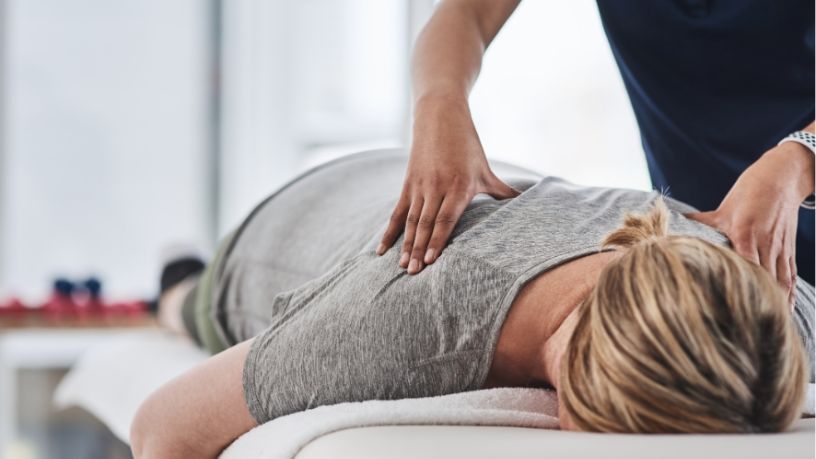Frozen shoulder (adhesive capsulitis) is a condition where your shoulder becomes painful and stiff.
On this page
Key takeaways
It’s not always clear why some people develop frozen shoulder, but it can be caused by an injury, and medical conditions like diabetes can increase your risk.
Taking painkillers and doing exercises as guided by a physiotherapist can help ease your symptoms.
Your shoulder joint is surrounded by a strong capsule, which is covered by tendons and muscles. Frozen shoulder happens when this capsule becomes thickened, tighter and inflamed. This stops your shoulder from being able to move freely. You can get frozen shoulder in just one shoulder or both.
Up to 5 in 100 people will get frozen shoulder at some point in their lives.1 You’re more likely to get it between the ages of 40 and 70, and it’s slightly more common in women than men.
Frozen shoulder causes
It’s not always exactly clear why some people develop a frozen shoulder. Sometimes there seems to be no underlying cause at all. This is known as ‘primary’ (or idiopathic) frozen shoulder.2
If there is an underlying cause, it’s known as ‘secondary’ frozen shoulder. This may be due to a shoulder injury, such as an injury to your rotator cuff (the tendons and muscles in your shoulder), or it might happen if you’ve had to keep your shoulder still for a long time (perhaps after a fracture or surgery on your shoulder).
Although doctors aren’t sure why, some medical conditions can also increase your risk of getting frozen shoulder. These include:
- diabetes
- underactive or overactive thyroid
- heart disease or stroke.3
Frozen shoulder symptoms
There are 2 main symptoms of frozen shoulder:
- pain. This comes on gradually and may become severe. Frozen shoulder pain is often worse at night or when you move your shoulder joint
- stiffness. This can stop you from moving your shoulder normally. It can make it difficult to do everyday tasks such as driving or dressing yourself.
If you have any of these symptoms, see a GP or physiotherapist for advice.
Stages of frozen shoulder
There are 3 stages of frozen shoulder, which can overlap and be difficult to tell apart.
- Painful or ‘freezing’ phase: You start to get pain in your shoulder during this phase, and it slowly gets worse. This phase may last from 2 to 9 months.
- Stiffness or ‘frozen’ phase: The pain may get less severe, but it gets harder to move your shoulder. This can affect your day-to-day activities. This phase may last between 4 months and a year.
- Resolution or ‘thawing’ phase: The stiffness gradually eases and most gradually recover their shoulder function. This phase can sometimes take up to 3 years or more.
For most people, a frozen shoulder gets better within 18 months to 2 years. But it can take much longer for some people. If you’re having shoulder pain or stiffness, it’s best to seek advice from your GP or physio rather than just waiting for it to get better on its own.
Diagnosis of frozen shoulder
Your GP or physiotherapist will ask about your symptoms, including:
- how long you’ve had them
- when you tend to get them
- if anything makes it worse
- whether it affects your usual activities.
They’ll also ask you about your medical history to determine if you have any existing conditions which make you more likely to develop frozen shoulder or could impact your recovery.
Your GP or physiotherapist will examine your shoulder to see if it’s tender and assess how well you can move your shoulder by performing a range of tests. These may include:
- gently moving your arm for you (‘passive movement’)
- asking you to move your arm yourself into different positions (‘active movement’).
These tests let them see if the range of movement of your shoulder is reduced. Tell your GP or physio if the exercises feel very uncomfortable for you.
You won’t need a shoulder X-ray to diagnose frozen shoulder, but your GP may suggest you have one to rule out other conditions.
Self-help
There is a lot you can do to help yourself if you have a frozen shoulder. Try these tips alongside advice and treatment from your GP or physiotherapist:4
- If you need pain relief, you can take over-the-counter painkillers like paracetamol or ibuprofen. Talk to your GP or pharmacist if you have any questions about your medication.
- Try heat or cold packs. These may help to reduce stiffness and swelling and relieve pain.
- Support your arm with pillows while sleeping or while sitting in a chair. In bed, this can prevent you rolling onto the affected side. A pillow in the small of your back while sitting can improve your posture, which may help.
- Try to keep using your arm as normally as you can. It helps to keep your shoulder moving. You may need to stop certain activities that worsen the pain. Aim for a balance between rest and activity.
Treatment of frozen shoulder
Frozen shoulder can often get better on its own, but if it’s left untreated it might take several years to fully recover.
The aims of any treatment include reducing your pain and improving the movement in your shoulder. It’s best to start treatment as early as possible.
Physiotherapy
Physiotherapy is an important treatment for frozen shoulder.
You’ll usually have an initial course of physiotherapy for 6 weeks. This may go on longer if it’s helping. Your physio can give advice on how to manage your symptoms, including how you can modify your usual activities to reduce any pain. Physiotherapy may also involve a wide range of different treatments including:
- at home exercises. These help to reduce pain and improve the function and movement of your frozen shoulder
- manual therapy (mobilisation). This is when your physio moves your shoulder joint in a particular way to help relieve any pain or stiffness. It may also help restore normal movement.
Joint injections
Hydrodilatation
Your GP may also recommend a treatment called hydrodilatation. This procedure involves injecting your shoulder with a sterile salt water solution (saline), and is done with the guidance of an X-ray or ultrasound. Sometimes, corticosteroid or local anaesthetic is added. The injection should stretch the shoulder capsule and free up the joint to help improve your movement.
Surgery
Most people with frozen shoulder find their symptoms improve eventually with self-help and non-surgical treatments. But if these haven’t helped, your GP may refer you to an orthopaedic surgeon, a doctor who specialises in bones and joints.
Your orthopaedic surgeon may recommend one of the following procedures:
- shoulder manipulation under anaesthetic (MUA). In this procedure, your surgeon moves your shoulder into positions that will stretch or tear the tightened capsule. This should increase the movement you have in your shoulder. You will have a general anaesthetic for this procedure, which means you’ll be asleep
- arthroscopic capsular release. Your surgeon uses keyhole surgery to look inside your shoulder joint, usually under general anaesthetic. They use surgical instruments to divide parts of the capsule in your shoulder joint. You may have this surgery at the same time as an MUA.
Member Health Programs
Discover health cover that's right for you with a range of personalised programs and services designed to support your health and wellbeing.
Exercises for frozen shoulder
Regular, gentle exercise and stretching may relieve frozen shoulder symptoms and help you recover. As your shoulder range improves, gentle strengthening exercises will help you get back to your previous level of function. Your physiotherapist will show you various exercises you can do at home. It’s important to follow their advice.
Prevention of frozen shoulder
Frozen shoulder cannot be prevented, but early treatment can help relieve your symptoms and reduce the time it takes to recover.
There may be some things you can do to prevent secondary frozen shoulder. This is when there is an underlying cause for your frozen shoulder, like an injury, shoulder surgery or another condition.
If you’ve had a shoulder injury or surgery, it’s important to keep your shoulder as mobile as possible afterwards. Follow advice from your surgeon or physiotherapist about wearing a sling and getting your shoulder moving again safely.
If you have diabetes, making sure it’s well managed may help to prevent secondary frozen shoulder.
This article was originally published on bupa.co.uk and has been amended in line with Australian guidelines.
Resources
The Australian Physiotherapy Association can help you find a physio near you.
Chronic Pain Australia provides education and support for those living with chronic pain.
Musculoskeletal Health Australia provides information and support for people living with arthritis and musculoskeletal conditions. Visit their website or call them on 1800 263 265.

At Bupa, trust is everything
Our health and wellbeing information is regularly reviewed and maintained by a team of healthcare experts, to ensure its relevancy and accuracy. Everyone's health journey is unique and health outcomes vary from person to person.
This content is not a replacement for personalised and specific medical, healthcare, or other professional advice. If you have concerns about your health, see your doctor or other health professional.
1Institute for Quality and Efficiency in Health Care. (2022). Overview: Frozen shoulder. National Library of Medicine.
2Brun, S. P. (2019). Idiopathic frozen shoulder. Australian Journal of General Practice, 48(11).
3Mezian, K., Coffey, R., & Chang, K. V. (2022). Frozen shoulder. StatPearls Publishing.
4Versus Arthritis. (2022). Shoulder pain. Versus Arthritis.
You might also like...
Rotator cuff injury: Symptoms, causes and treatment
Learn about rotator cuff injuries, symptoms, diagnosis and treatment options. Discover how to manage shoulder pain with tips from Bupa.
Back surgery: Types, procedures and recovery
Find out about the different types of back surgery used to treat back pain, how they work and what you need to do to prepare and recover.
Beware the post hospital blues
It’s common to experience the blues after being in hospital. We explore tips to manage them, what signs to look out for and when to seek help.
Understanding back pain: Causes, symptoms and treatment options
Learn what causes back pain, how to recognise symptoms, and your options for relief.





